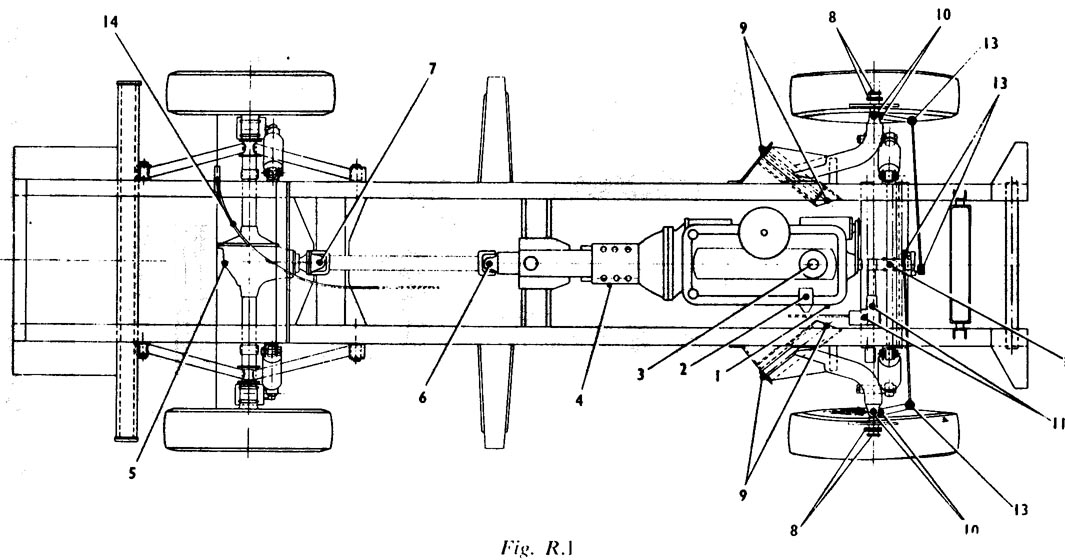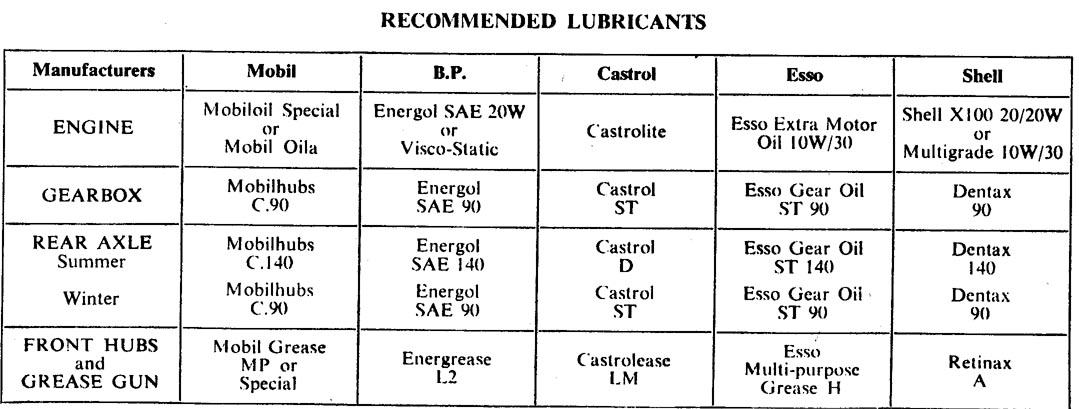Section R (26/12/08 )
LUBRICATION
R.1 Engine
R.2 Gearbox
R3. Rear axle
R4. Universal joints
R5. Wheel bearings
R6. Front suspension arm pivot-pins
R7. Front axle king pins
R8. Steering box, idler and track rods
R9. Handbrake
R10. General lubrication
|
|
||
|
1. Engine Drain Plug
08. Front Stub Axle Wheel Bearings
|
||
|
R1 ENGINE The lubrication of the engine is controlled by the
submerged gear type pump together with a full flow oil filter fitted
direct to the cylinder block. It is imperative that the correct grades of
oil are used, and those recommended are as follows : Checking Engine Oil Level It is advisable each day to check the oil content in
the engine, particularly before the commencement of a long journey. The
engine consumes more oil when run at sustained high speeds, and the level
must be watched carefully when the car is operated in such
conditions. Draining Engine Oil After the first 300 miles (480 km), the engine oil
should be drained and thereafter every 5.000 miles (8,000 km) or earlier
if excessive fouling has taken place. The oil filter element should also
be changed after every 5,000 miles or whenever the sump is replenislied
with fresh oil. |
Filling the Sump The oil filler (3) is mounted on the top of the cadmium
plated rocker cover. When adding more oil to the engine, remove the filler
cap; the filler cap is of the oil bath air filter type. Do not tilt the
cap or oil will be spilled. Changing the Oil Filter Element The oil filter (2) is fitted direct to the cylinder
block, no connecting pipes to the engine being required. To replace the
filter element, remove the hexagon-headed bolt retaining the filter unit
to the cylinder block and withdraw the filter assembly. R2 GEARBOX The gearbox oil should he drained off after the first
1.000 miles (1.600 km). Thereafter the oil should be changed every 5,000
miles (8.000 km) and the level checked every 1,000 miles. It is preferable
to drain off the oil whilst still warm. This condition will assist the oil
flow. The combined filler-level plug (4) (located to the lower right of
the speedo-meter drive connection) is the re-filling point and care must
be taken not to overfill, as this may lead to clutch slip. R3 REAR AXLE As with the gearbox. the oil in the rear axle should be
changed at the first 1,000 miles (1,600 km) and thereafter at every 5,000
miles (8,000 km). The level should be checked every 1,000 miles (1.600
km). The replenishing of the gearbox with oil is effected via the filter and
level plug (5) which is centrally located on the axle case. R4 UNIVERSAL JOINTS The propeller shaft universal joints should be
lubricated periodically by applying a grease gun containing SAE 120 oil to
the nipples (6. 7) protruding on each spider (two nipples). |
|
|
R5 WHEEL BEARINGS Every 5,000 miles (8,000 km) the front stub axle wheel
bearings (8) should be replenished with a lithium-based bearing grease.
Dismantling and access to the bearings is discribed in the 'Front Hubs'
section. R6 FRONT SUSPENSION ARM PIVOT-PINS R7 FRONT AXLE KING PINS Every 2,000 miles (3,200 km.) a grease gun should be
applied to the front axle king pins (10) (four nipples). R8 STEERING BOX, IDLER AND TRACK RODS Lubrication of the steering is via grease nipples at the following points. |
Steering Box (11) (two nipples). It is recommended that these points be lubricated every
2.000 miles (3,200 km) using a grease gun. R9 HANDBRAKE The greasing nipple located on the handbrake cable (14)
should receive grease gun attention every 4.000 miles (6,400 km). R10 GENERAL LUBRICATION Periodically,a few drops of oil should be applied to
the throttle linkage, heater control cables, choke cables, door hinges
etc. Details of the correct lubricants are to be found on
the identification plate fitted to the car bulkhead or table (Fig. R.2).
|
|

